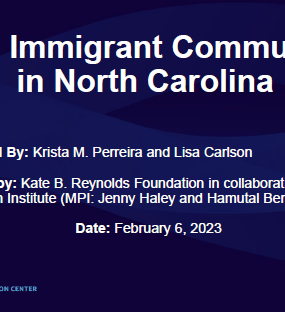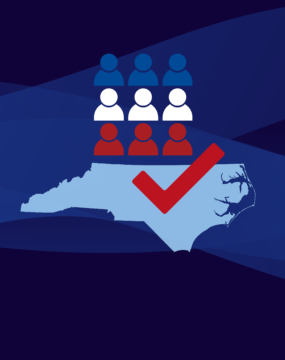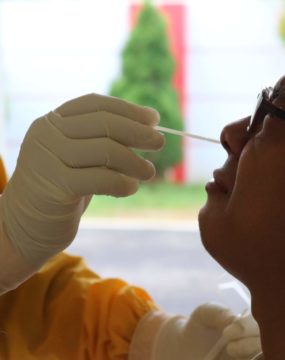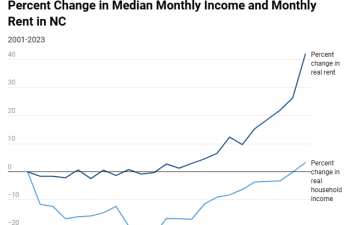What we deliver
We help people understand the population changes facing their communities
We help you understand what data you need, and where and how to access that data.
We use rigorous methods to translate the data and provide meaningful context.
We strengthen the capacity of your organization to communicate data-driven ideas.
Using datasets and primary research, we provide accessible and customizable insights in whatever format makes the most sense for your team. Learn more about our work and explore stories of how our clients use our tools and expertise to inform their decisions.

The Center for Women’s Health Research (CWHR) at the University of North Carolina School of Medicine released the 12th edition of our North Carolina Women’s Health Report Card on May 9, 2022. This document is a progress report on the health and health care needs of North Carolina’s 5+ million women. Current areas of research targeted by the Center include prevention, cancers affecting women, chronic disease (including cardiovascular health, diabetes, and obesity), women’s mental health, and substance abuse. It is the only health report of its kind in North Carolina. Carolina Demography collected the data…

Dr. Krista Perreira is a health economist who studies disparities in health, education, and economic well-being. In collaboration with the Urban Institute, she recently co-led a study funded by the Kate B. Reynolds Foundation to study barriers to access to the safety net for eligible immigrants and mixed-status families in North Carolina and identify promising strategies to increase access. Dr. Perreira, a faculty fellow at the Carolina Population center and longtime collaborator with Carolina Demography, asked us to assist with demographic analysis and communicating findings to community leaders and funders. What we did We identified…

Our material helped the NC Local News Lab Fund better understand and then prioritize their funding to better serve existing and future grant recipients in North Carolina. The North Carolina Local News Lab Fund was established in 2017 to strengthen organizations and people working to build a local news and information ecosystem in North Carolina. In addition to grantmaking, the Fund has established the North Carolina Local News Workshop housed within Elon’s School of Communications. Both operations support the state’s civic infrastructure. Recently, the Fund asked Carolina Demography to create an interactive map synthesizing demographic…

The Wake County Public School System (WCPSS), which serves over 160,000 students, is the largest public school district in North Carolina. To better prepare for school siting needs, WCPSS asked Carolina Demography to project long-range forecasts (10-year) of school enrollment by grade. They also asked us to help them better understand the impact of COVID-19 on these projections. Statewide, there were 63,000 fewer students enrolled in public schools in fall 2020 compared to the prior year. Enrollment patterns substantially changed for most grades --- in particular, there were significantly fewer kindergarteners enrolled compared to prior…

Alamance Community College (ACC) is a public community college with campuses in Graham, North Carolina and Burlington, North Carolina. They asked Carolina Demography to help them understand what they would need to know in order to plan for recruitment, enrollment and future programs over the next decade. Approach We worked with ACC to formulate key questions concerning Alamance County’s demographic, workforce, income and education trends, then identified the most useful datasets pulled from a wide variety of public sources. We prepared a databook with projections of demographic and economic trends in Alamance County and created…

In 2020, the NC Counts Coalition provided funding to more than 60 NC-based organizations working to reach the communities most at-risk of being undercounted in the 2020 Census. The Coalition had previously worked with Carolina Demography to create a map identifying the communities across the state that could be hard to count in the 2020 Census. They used this map to identify their priority areas and make funding decisions. As Census collection efforts began, they wanted us to provide their grant recipients with real-time information about Census counts in their targeted communities so that they…
Completing the FAFSA is strongly and positively associated with postsecondary enrollment. An analysis of data from the National Center for Education Statistics shows that 88% of high school seniors who completed a FAFSA in 2012-13 had attended college by February 2016, compared to 49% of students who did not file a FAFSA. Increasing FAFSA completion is also a fundamental step in North Carolina’s efforts to meet the statewide education attainment goal. But how could school districts best track their students’ progress and increase FAFSA participation? That was the question at the heart of our recent…

Our clients were, in their words “swimming in data soup.” They often had to collaborate together on county and town-level projects, and wanted to ensure that they were using numbers from the same data sources and had the same understanding about the status of their community. Their goal: to align around their work and their messaging around that work. They enlisted Carolina Demography to streamline their existing processes for acquiring, updating, and maintaining the data they used for their community reports and presentations and to inform decision-making by local governments, businesses, and non-profits. We set…

Launched on December 18, 2020, the UNC Gillings COVID-19 Dashboard provides a centralized resource center for information about COVID-19 in North Carolina. Using modern epidemiologic tools, the dashboard has become a resource for policy makers, researchers and anyone interested in learning more about COVID-19 in the state. The dashboard also provides county-level profiles and interactive COVID-19 data visualizations for North Carolina, allowing users to see what’s happening in their area of the state by mapping demographics, health outcomes, economic characteristics and more. Carolina Demography worked closely with the core project team to provide data and…

North Carolina’s 4th congressional district is currently represented by Congressman David Price. Mandatory redistricting in 2019 changed the boundaries of the district, which now encompasses all of Durham County, Orange County, Granville County, and Franklin County, as well as parts of Chatham County, Wake County, and Vance County. In 2020, David Price’s office approached us because they wanted to better understand the context of their new district and learn more about who their new constituents were. They asked us to create a comprehensive demographic and economic profile of the redrawn 4th district, and to detail…

This blog post expands on a previous blog post that examined housing cost burden across NC by focusing on the disparities between housing cost burden for homeowners and renters. In North Carolina, 66.8% of occupied housing units are owner-occupied, while…

In recent years, housing has become a hot-button issue both nationwide and in our state, as many people struggle to find secure, affordable housing options. David Rouse, Ben Hitchings, and Anita Brown-Graham of the UNC School of Government’s ncIMPACT Initiative…

In recognition of Veterans Day, Tuesday, November 11th, we are providing some statistics about North Carolina’s veteran population. The most current version was published on November 12th, 2025, with information from 2023 and 2024. Please note that the county veterans…
Your support is critical to our mission of measuring, understanding, and predicting population change and its impact. Donate to Carolina Demography today.